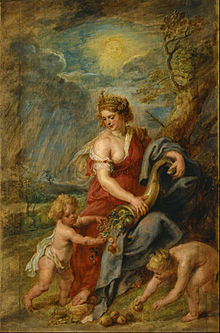Abundantia
| Abundantia | |
|---|---|
Goddess of abundance, money-flow, prosperity, fortune, valuables, and success | |
 A painting of Abundantia made by Peter Paul Rubens | |
| Symbol | Cornucopia |
In
medieval France. Abundantia would carry a cornucopia that was filled with grain and coins.[3] She would occasionally leave some of her grain or money at someone's house as a gift.[3]
In Rome
The
grain supply.[4] Like Annona, Abundantia was a "virtue in action" in such locations as the harbor, where grain entered the city.[4] Coinage in Rome depicts her either holding the cornucopia or pouring out the riches contained within the cornucopia. Occasionally she is depicted as holding wheat or standing on a ship. It is unknown what her appearance on ships represents. This could symbolize the wealth the conquests of the Rome brought to the Empire.[1] Abundantia appears on the medals of many emperors. Such as Trajan, Antoninus Pius, Caracalla, Elagabalus, Severus Alexander, Gordian, Decius, Gallienus, Tetricus, Probus, Numerian, Carinus, Carus, Diocletian, and Galerius.[6] She appears alongside one of several inscriptions: Abundantia, Abundantia Perpetua, Augustorum Nostrorum, Augustorum Augg NN, and Augustia Aug.[6] Mithraic iconography on a vase from Lezoux, in the Roman province of Gallia Aquitania depicts this deity seating, and holding a cornucopia as a symbol of "the abundance that stems from Mithras' act."[7] Abundantia was depicted on a fountain in Pompeii.[1]
Possible survivals
It has been suggested that the
burning at the stake.[12]
Later art and allegory
In later
Western art, Abundantia is often portrayed holding her cornucopia and sheaves of corn or wheat.[13]
See also
- Fortuna
- Tyche
- 151 Abundantia
References
- ^ a b c d e "Abundantia, Roman Goddess of Abundance". www.thaliatook.com. Retrieved 2020-09-10.
- ^ Joseph Spence. Polymetis: Or, An Enquiry Concerning the Agreement Between the Works of the Roman Poets, and the Remains of the Antient Artists: Being an Attempt to Illustrate Them Mutually from One Another. In Ten Books. R. Dodsley, 1747, p. 148.
- ^ ISBN 978-1-4019-0473-9.
- ^ a b c J. Rufus Fears, "The Cult of Virtues and Roman Imperial Ideology," Aufstieg und Niedergang der römischen Welt II.17.2 (1981), p. 812.
- ^ Ovid, Metamorphoses; 9.87–88, as cited by Fears, p. 821.
- ^ a b Universal Technological Dictionary Volume 1. London: Baldwin. 1823.
- ^ Manfred Claus, The Roman Cult of Mithras: The God and His Mysteries, translated by Richard Gordon (Routledge, 2000, originally published 1990 in German), p. 118.
- ^ Paul-Marie Duval, "Rosmerta," American, African, and Old European Mythologies (University of Chicago Press, 1993), p. 221.
- ^ Edward Burnett Tylor, excerpt from Primitive Culture, in Understanding Religious Sacrifice: A Reader (Continuum, 2003, 2006), p. 22.
- ^ Alan E. Bernstein, "The Ghostly Troop and the Battle over Death: William of Auvergne (d. 1249)," Rethinking Ghosts in World Religions (Brill, 2009), p. 144.
- ^ Benjamin Thorpe, Northern Mythology (London, 1861), vol. 1, p. 281; Jacob Grimm, Teutonic Mythology (English translation London, 1880), pp. 283–288.
- ^ Hans Peter Broedel, The Malleus Maleficarum and the Construction of Witchcraft: Theology and Popular Belief (Manchester University Press, 2003), p. 109.
- ^ Jürg Meyer zur Capellen, Raphael: The Roman Religious Paintings, ca. 1508-1520 (Arcos, 2005), p. 264.
External links
 Media related to Abundantia at Wikimedia Commons
Media related to Abundantia at Wikimedia Commons

